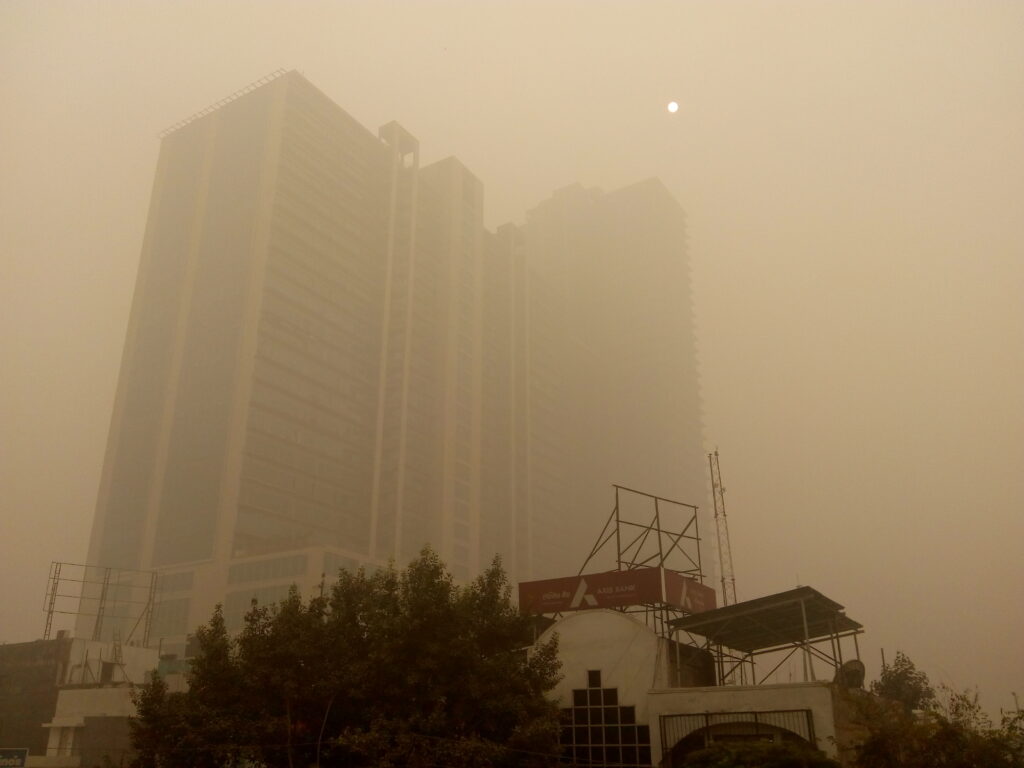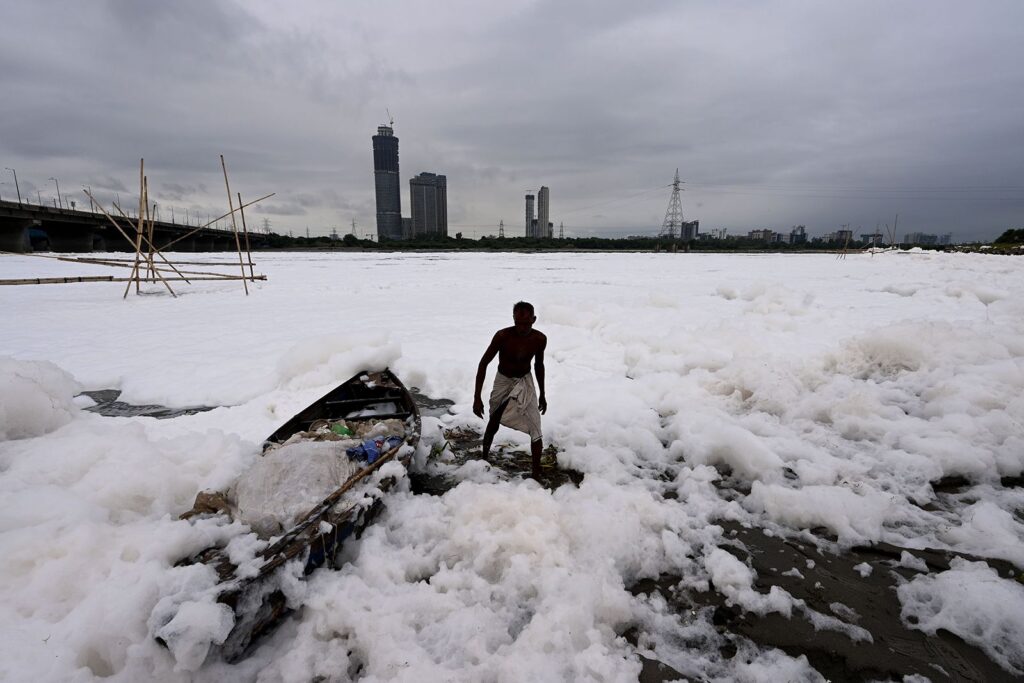
Newswriters News Desk
Discover the latest insights on air and water pollution in Delhi/NCR, including real-time AQI levels, health risks, economic costs, and effective government strategies to reduce environmental hazards in India’s capital region.
Delhi/National Capital Region (NCR) continues to grapple with severe pollution challenges in 2025, predominantly air and water pollution, which pose significant threats to public health, the environment, and economic productivity. Air quality has deteriorated to ‘very poor’ levels with an Air Quality Index (AQI) exceeding 300 in recent days, triggering Stage II of the Graded Response Action Plan (GRAP).
Key causes include vehicular emissions, industrial activities, construction dust, stubble burning from neighboring states, and seasonal factors like firecrackers during festivals. Water pollution, particularly in the Yamuna River, remains acute due to untreated sewage and industrial effluents. Despite some improvements in annual AQI metrics (a 17% reduction compared to previous years), Delhi retains its status as one of the world’s most polluted cities, with fine particulate matter (PM2.5) linked to approximately 10,000 premature deaths annually.
Delhi/NCR, home to over 30 million people, is a bustling economic hub but also a hotspot for multifaceted pollution. Pollution here encompasses air, water, noise, and soil degradation, with air pollution being the most visible and debated issue. Historical trends indicate worsening conditions since the early 2000s, exacerbated by rapid urbanization, population growth, and industrial expansion. In 2025, despite global and national efforts toward sustainability, Delhi’s pollution levels remain alarmingly high, often surpassing World Health Organization (WHO) guidelines by 10-16 times.
Types of Pollution in Delhi/NCR
Pollution in Delhi/NCR manifests in various forms, each interconnected and amplified by the region’s geography and meteorology.
Air Pollution
Air pollution is the dominant concern, characterized by high levels of PM2.5, PM10, nitrogen dioxide (NO2), and ozone. Real-time data from the Central Pollution Control Board (CPCB) shows PM2.5 AQI at 321 and PM10 at 733 in areas like Anand Vihar. Delhi’s annual AQI in 2025 stands at 136, marking a 17% improvement from 2022’s 174, yet it remains hazardous. Winter months see spikes due to temperature inversions trapping pollutants.
Water Pollution
The Yamuna River, flowing through Delhi, is one of India’s most polluted waterways. It receives untreated sewage from over 1,500 drains, industrial waste, and agricultural runoff, leading to toxic foam formations and dissolved oxygen levels near zero in stretches. Recent images highlight frothy, chemical-laden surfaces, rendering the river ecologically dead in urban segments. This pollution affects groundwater and downstream communities.
Other Forms
Noise pollution from traffic and construction exceeds 80 decibels in many areas, contributing to stress-related health issues. Soil pollution arises from heavy metal contamination via waste dumping, impacting agriculture in peri-urban NCR zones.
Causes of Pollution
Delhi/NCR’s pollution stems from a mix of anthropogenic and natural factors, with local sources dominating (estimated at 96% for air pollution).
Public discourse on X highlights political debates, with users blaming neighboring states for stubble burning while others emphasize urban mismanagement. Water pollution is primarily from untreated sewage (80% of Yamuna’s pollution load) and illegal industrial discharges.
Current Status in 2025
As of October 20, 2025, Delhi’s air quality has plunged to ‘very poor’ (AQI 300+), with some areas like Anand Vihar reaching ‘severe’ (AQI 400+). This follows Diwali celebrations, where firecrackers exacerbated existing pollution from vehicles and stubble burning. Annual trends show marginal improvements, but Delhi still tops global pollution rankings, with PM2.5 levels potentially reducing life expectancy by 8.2 years. Yamuna’s condition remains dire, with recent toxic foam sightings during festivals.
Health Impacts
Prolonged exposure leads to respiratory ailments like asthma and chronic obstructive pulmonary disease (COPD), cardiovascular issues, and increased cancer risk. PM2.5 is responsible for ~10,000 premature deaths yearly in Delhi. Vulnerable groups—children, elderly, and low-income communities—suffer most.
Economic Impacts
Pollution costs India ~1-2% of GDP annually through healthcare expenses and lost productivity. In Delhi/NCR, it disrupts tourism, real estate, and workforce efficiency, with estimates of $10-15 billion in annual losses.
Environmental Impacts
Air pollution contributes to acid rain and biodiversity loss, while Yamuna’s contamination kills aquatic life and pollutes soil. It also exacerbates climate change by increasing black carbon emissions.
Government Measures and Policies
The Indian government has implemented several initiatives:
Analysis: Effectiveness and Challenges
While policies like GRAP provide short-term relief, long-term effectiveness is limited by poor implementation, corruption, and lack of public compliance. Stubble burning contributes minimally (4%), yet it’s politicized, diverting focus from local sources like vehicles (96%).
Recommendations
- Enhance Enforcement: Strengthen monitoring with AI-driven sensors and stricter penalties for violators.
- Promote Sustainable Transport: Accelerate EV adoption and expand metro networks to cut vehicular emissions by 50% by 2030.
- Inter-State Collaboration: Subsidize stubble management tech for farmers and integrate regional air-shed management.
- Public Engagement: Launch awareness campaigns via social media, emphasizing local actions over blame-shifting.
- Water-Specific Actions: Invest in 100% sewage treatment plants for Yamuna by 2027 and regulate industrial effluents.
- Research and Innovation: Fund studies on pollution-health linkages and pilot green tech in NCR.
Pollution in Delhi/NCR is a complex, entrenched crisis requiring urgent, multifaceted interventions. While 2025 shows incremental progress, the city’s ‘very poor’ air and toxic waters underscore the gap between policy and reality.
Addressing root causes through collaborative governance, technological innovation, and behavioral change is essential to safeguard public health and ensure sustainable development. Without bolder actions, Delhi risks perpetuating its dubious title as a global pollution leader.




